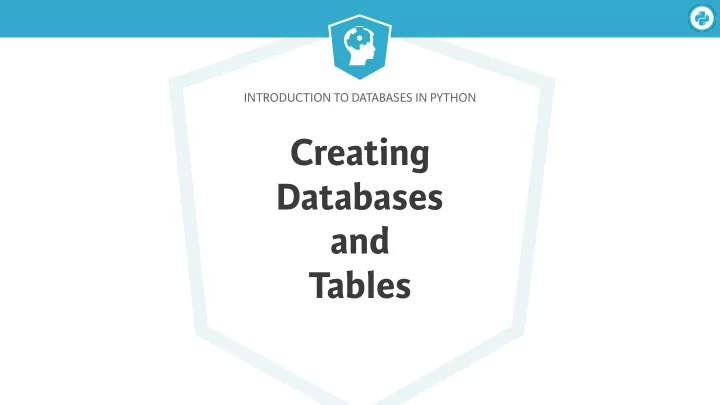

INTRODUCTION TO DATABASES IN PYTHON Creating Databases and Tables
Introduction to Databases in Python Creating Databases ● Varies by the database type ● Databases like PostgreSQL and MySQL have command line tools to initialize the database ● With SQLite, the create_engine() statement will create the database and file is they do not already exist
Introduction to Databases in Python Building a Table In [1]: from sqlalchemy import (Table, Column, String, ...: Integer, Decimal, Boolean) In [2]: employees = Table('employees', metadata, ...: Column('id', Integer()), ...: Column('name', String(255)), ...: Column('salary', Decimal()), ...: Column('active', Boolean())) In [3]: metadata.create_all(engine) In [4]: engine.table_names() Out[4]: [u'employees']
Introduction to Databases in Python Creating Tables ● Still uses the Table object like we did for reflection ● Replaces the autoload keyword arguments with Column objects ● Creates the tables in the actual database by using the create_all() method on the MetaData instance ● You need to use other tools to handle database table updates, such as Alembic or raw SQL
Introduction to Databases in Python Creating Tables - Additional Column Options ● unique forces all values for the data in a column to be unique ● nullable determines if a column can be empty in a row ● default sets a default value if one isn’t supplied.
Introduction to Databases in Python Building a Table with Additional Options In [1]: employees = Table('employees', metadata, ...: Column('id', Integer()), ...: Column('name', String(255), unique=True, ...: nullable=False), ...: Column('salary', Float(), default=100.00), ...: Column('active', Boolean(), default=True)) In [2]: employees.constraints Out[2]: {CheckConstraint(... Column('name', String(length=255), table=<employees>, nullable=False), Column('salary', Float(), table=<employees>, default=ColumnDefault(100.0)), Column('active', Boolean(), table=<employees>, default=ColumnDefault(True)) ... UniqueConstraint(Column('name', String(length=255), table=<employees>, nullable=False))}
INTRODUCTION TO DATABASES IN PYTHON Let’s practice!
INTRODUCTION TO DATABASES IN PYTHON Inserting Data into a Table
Introduction to Databases in Python Adding Data to a Table ● Done with the insert() statement ● Insert() takes the table we are loading data into as the argument ● We add all the values we want to insert in with the values clause as column=value pairs ● Doesn’t return any rows, so no need for a fetch method
Introduction to Databases in Python Inserting One Row In [1]: from sqlalchemy import insert In [2]: stmt = insert(employees).values(id=1, name='Jason', salary=1.00, active=True) In [3]: result_proxy = connection.execute(stmt) In [4]: print(result_proxy.rowcount) Out[4]: 1
Introduction to Databases in Python Inserting Multiple Rows ● Build an insert statement without any values ● Build a list of dictionaries that represent all the values clauses for the rows you want to insert ● Pass both the stmt and the values list to the execute method on connection
Introduction to Databases in Python Inserting Multiple Rows In [1]: stmt = insert(employees) In [2]: values_list = [ {'id': 2, 'name': 'Rebecca', 'salary': 2.00, 'active': True}, {'id': 3, 'name': 'Bob', 'salary': 0.00, 'active': False} ] In [3]: result_proxy = connection.execute(stmt, values_list) In [4]: print(result_proxy.rowcount) Out[4]: 2
INTRODUCTION TO DATABASES IN PYTHON Let’s practice!
INTRODUCTION TO DATABASES IN PYTHON Updating Data in a Table
Introduction to Databases in Python Updating Data in a Table ● Done with the update statement ● Similar to the insert statement but includes a where clause to determine what record will be updated ● We add all the values we want to update with the values clause as column=value pairs
Introduction to Databases in Python Updating One Row In [1]: from sqlalchemy import update In [2]: stmt = update(employees) In [3]: stmt = stmt.where(employees.columns.id == 3) In [4]: stmt = stmt.values(active=True) In [5]: result_proxy = connection.execute(stmt) In [6]: print(result_proxy.rowcount) Out[6]: 1
Introduction to Databases in Python Updating Multiple Rows ● Build a where clause that will select all the records you want to update
Introduction to Databases in Python Inserting Multiple Rows In [1]: stmt = update(employees) In [2]: stmt = stmt.where( employees.columns.active == True ) In [3]: stmt = stmt.values(active=False, salary=0.00) In [4]: result_proxy = connection.execute(stmt) In [5]: print(result_proxy.rowcount) Out[5]: 3
Introduction to Databases in Python Correlated Updates In [1]: new_salary = select([employees.columns.salary]) In [2]: new_salary = new_salary.order_by(desc( ...: employees.columns.salary) ) In [3]: new_salary = new_salary.limit(1) In [4]: stmt = update(employees) In [5]: stmt = stmt.values(salary=new_salary) In [6]: result_proxy = connection.execute(stmt) In [7]: print(result_proxy.rowcount) Out[7]: 3
Introduction to Databases in Python Correlated Updates ● Uses a select() statement to find the value for the column we are updating ● Commonly used to update records to a maximum value or change a string to match an abbreviation from another table
INTRODUCTION TO DATABASES IN PYTHON Let’s practice!
Introduction to Databases in Python Deleting Data from a Database
Introduction to Databases in Python Deleting Data from a Table ● Done with the delete() statement ● delete() takes the table we are loading data into as the argument ● A where() clause is used to choose which rows to delete ● Hard to undo so BE CAREFUL!!!
Introduction to Databases in Python Deleting all Data from a Table In [1]: from sqlalchemy import delete In [2]: stmt = select([ func.count(extra_employees.columns.id)]) In [3]: connection.execute(stmt).scalar() Out[3]: 3 In [4]: delete_stmt = delete(extra_employees) In [5]: result_proxy = connection.execute(delete_stmt) In [6]: result_proxy.rowcount Out[6]: 3
Introduction to Databases in Python Deleting Specific Rows ● Build a where clause that will select all the records you want to delete
Introduction to Databases in Python Deleting Specific Rows In [1]: stmt = delete(employees).where( employees.columns.id == 3) In [2]: result_proxy = connection.execute(stmt) In [3]: result_proxy.rowcount Out[3]: 1
Introduction to Databases in Python Dropping a Table Completely ● Uses the drop method on the table ● Accepts the engine as an argument so it knows where to remove the table from ● Won’t remove it from metadata until the python process is restarted
Introduction to Databases in Python Dropping a table In [1]: extra_employees.drop(engine) In [2]: print(extra_employees.exists(engine)) Out[2]: False
Introduction to Databases in Python Dropping all the Tables ● Uses the drop_all() method on MetaData
Introduction to Databases in Python Dropping all the Tables In [1]: metadata.drop_all(engine) In [2]: engine.table_names() Out[2]: []
INTRODUCTION TO DATABASES IN PYTHON Let’s practice!
Recommend
More recommend